- Home
- Essential Knots
- Sheet Bend
The Sheet Bend: How to Join Two Lines of Different Sizes
In a Nutshell...
The sheet bend is a fundamental knot for any sailor. It is the go-to method for securely joining two lines, particularly when they are of different diameters. Unlike other knots, its design ensures a firm hold on lines of unequal size, making it a reliable choice for everything from tying on a new halyard to securing a fender. It's easy to tie, easy to inspect, and—most importantly, tied properly—it won't slip under normal loads.
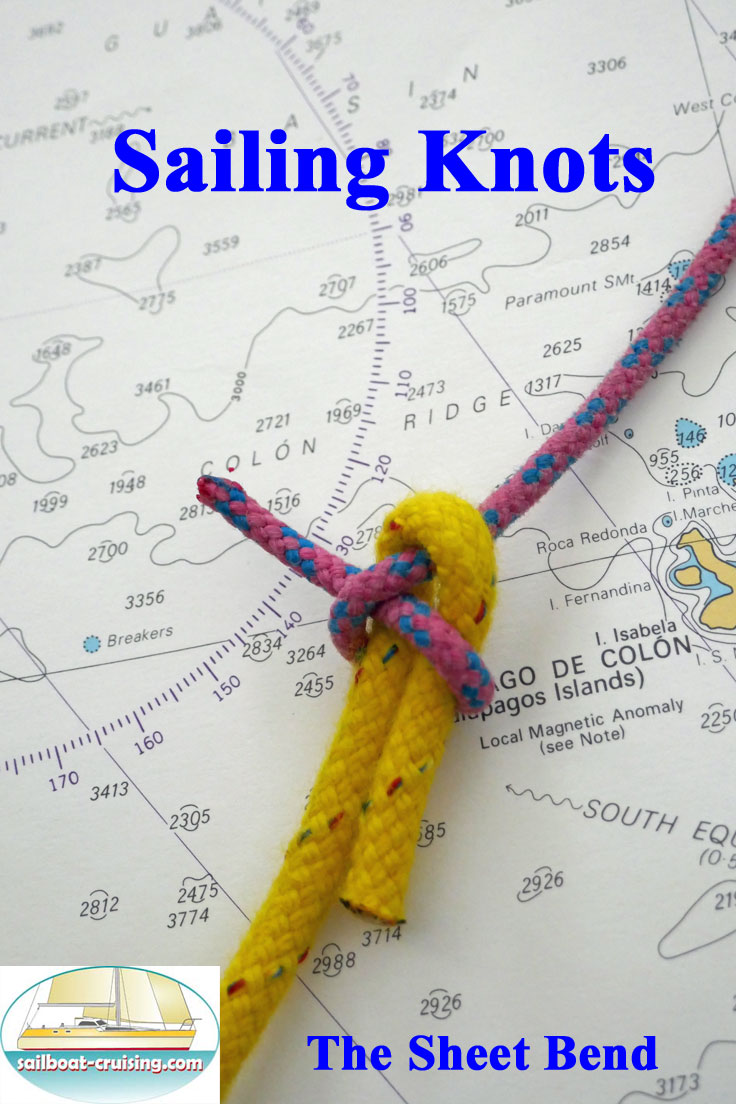
Table of Contents
A Critical Knot for Every Sailor’s Repertoire
A good knot is like a reliable friend—always there when you need it and never lets you down. The sheet bend is one of those friends. It’s a workhorse of a knot, and in my years on the water, I've used it countless times to solve a variety of problems. For instance, when laying up my boat 'Alacazam' ashore for the Caribbean hurricane season I remove the halyards and replace them with smaller diameter mousing lines (aka 'messengers') to reduce the windage and protect the anodising on her aluminium mast.
When the time comes to replace the halyards, the knot to use to attach the mousing line to the end of the halyard is the sheet bend. Any other knot will be too bulky and/or will probably slip under tension.
While it's a simple knot, its proper use is a mark of a competent sailor. It’s a skill you should master before you ever leave the dock. The beauty of the sheet bend is its ability to reliably join lines of unequal diameters. When you use a knot like a square knot for this purpose, the smaller line is at risk of slipping under tension—a potentially dangerous situation.
Anatomy of a Sheet Bend
Before we get into the "how-to," it helps to understand what you're tying. The sheet bend is essentially a bight in one line that is secured by the end of another. The two lines are often referred to as the "standing part" (the line with the bight) and the "working end" (the line that is passed through the bight). When joining lines of different sizes, the thicker line should always be used for the bight.
How to Tie a Sheet Bend
- Form a Bight: Take the thicker of the two lines and form a bight (a U-shaped loop). This is the foundation of the knot.
- Pass the Working End: Take the end of the thinner line and pass it up through the bight.
- Wrap Around the Standing Part: Wrap the thinner line's working end around the standing part of the thicker line, going behind the bight.
- Tuck & Secure: Tuck the working end of the thinner line under its own standing part, within the loop of the bight.
- Dress & Tighten: Pull on both standing parts to dress the knot, making sure everything is snug and tight. You’ll see that the working end of the thinner line is held securely against the thicker line's bight.
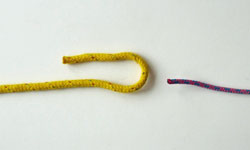
Stage 1
Form a bight in the thicker line;
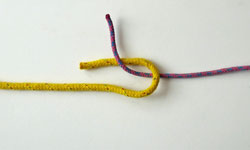
Stage 2
Insert the thinner line into the bight from back to front;

Stage 3
Tuck the working end of the thinner line under the bight of the thicker line.
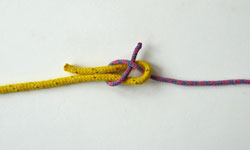
Stage 4
Now tuck the working end of the thinner line under its own standing part, to lock it against the bight of the thicker line. All that needs to be done now...
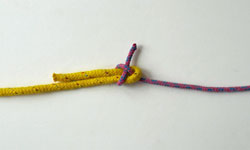
Stage 5
...is to cinch it up tight, and you have a finished Sheetbend.
It's important to remember that the two bitter ends (the tails of the lines) should lie on the same side of the finished knot. If they are on opposite sides, you've tied a "left-handed" sheet bend, which is considered less secure. For a critical application, I recommend adding a second, identical sheet bend on top of the first. This is called a double sheet bend and offers even greater security.
How to Tie the Double Sheet Bend

Stage 1
Form a bight in the thicker line;

Stage 2
Insert the thinner line into the bight from back to front;

Stage 3
Tuck the working end of the thinner line under the bight of the thicker line.

Stage 4
Now tuck the working end of the thinner line under its own standing part and...
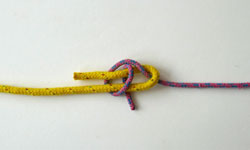
Stage 5
...tuck it under the bight of the thicker line for a second time;
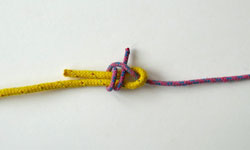
Stage 6
Now tuck the working end of the thinner line under its own standing part, to lock it against the bight of the thicker line.
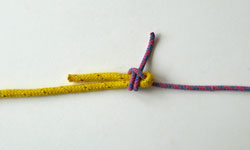
Stage 7
Cinch it up tight and you have the completed Double sheet Bend.
Common Uses & Applications Onboard
The sheet bend has a wide range of uses on a sailboat:
1. Joining Two Ropes
- Different thicknesses: Ideal for tying a thinner line (like a messenger line) to a thicker one (like a halyard or mooring line).
- Temporary extensions: Useful when you need to extend a line quickly without splicing.
2. Messenger Line Transfers
- When reeving halyards or control lines through mast sheaves, a sheet bend can attach a lightweight messenger line to the rope being replaced or installed.
3. Rigging Repairs
- At a pinch, it can temporarily join broken or frayed lines until a proper splice or replacement is done.
4. Securing Sail Ties or Lashings
- Occasionally used to tie sail ties or lashings when stowing sails, especially if the lines are mismatched or improvised.
5. Towing or Mooring Assistance
- Can be used to join a painter line to a tow rope or to extend a mooring line when docking in unfamiliar or awkward spots.
Sheet Bend & Other Knots
Let’s take a look at how the sheet bend compares to other common knots used for joining lines.
| Knot | Primary Use | Best For | Pros | Cons |
|---|---|---|---|---|
| Sheet Bend | Joining two lines | Lines of unequal size | Very secure, easy to inspect, easy to untie | Less secure on lines of equal size |
| Square Knot | Tying a line around an object | Tying reef points, securing bundles | Simple, quick to tie | Can slip under load, unreliable for joining lines |
| Bowline | Forming a secure loop | Tying lines to a post, rigging | Does not slip, easy to untie | Not for joining two lines together |
| Fisherman's Knot | Joining two lines | Monofilament, small diameter lines | Extremely secure, very compact | Difficult to untie, can bind |
There's several more that you really should know—they're all here in our article A Sailor's Guide to Essential Knots & Splicing...
By Dick McClary, RYA Yachtmaster Offshore & member of the Yachting Journalists Association (YJA)
Frequently Asked Questions (FAQs)
Can I use a sheet bend to join two lines of the same size?
Can I use a sheet bend to join two lines of the same size?
While the sheet bend can technically be used for this purpose, a Reef Knot or a Double Fisherman's Knot would be a more suitable and secure choice. The sheet bend truly excels when joining lines of different diameters.
How can I tell if my sheet bend is tied correctly?
How can I tell if my sheet bend is tied correctly?
The easiest way to check is to look at the two bitter ends of the lines. If they are on the same side of the knot, it's tied correctly. If they are on opposite sides, it's an insecure "left-handed" sheet bend.
Is a double sheet bend necessary?
Is a double sheet bend necessary?
For critical applications or when the lines are particularly slippery (e.g., modern synthetic lines), a double sheet bend provides added security and peace of mind. It’s always better to be safe than sorry, especially when offshore.
Sources
The Ashley Book of Knots (ABOK), by Clifford W. Ashley, a comprehensive guide to knots, their history, and their uses. https://www.wiley.com/en-us/The+Ashley+Book+of+Knots-p-9781442111100
Animated Knots by Grog: A helpful visual resource for learning how to tie a variety of knots. https://www.animatedknots.com/sheet-bend-knot
Recent Articles
-
Modern Boat Electronics and the Latest Marine Instruments
Dec 20, 25 05:27 PM
Should sailboat instruments be linked to the latest boat electronics as a fully integrated system, or is it best to leave them as independent units? -
Hans Christian 43: Classic Bluewater Cruiser & Liveaboard Sailboat
Dec 10, 25 04:37 AM
Explore the Hans Christian 43: a legendary heavy-displacement, long-keel sailboat. Read our in-depth review of its specs, design ratios, and suitability for offshore cruising and living aboard. -
Planning Your Sailboat Liveaboard Lifestyle: An Ocean Sailor's Guide
Dec 06, 25 05:18 AM
Seasoned sailors share their methodical risk analysis for planning a secure Sailboat Liveaboard Lifestyle, covering financial, property, and relationship risks.












